
Morus, a genus of flowering plants in the family Moraceae, consists of diverse species of deciduous trees commonly known as mulberries, growing wild and under cultivation in many temperate world regions. Generally, the genus has 64 identified species, three of which are well-known and are ostensibly named for the fruit color of the best-known cultivar: white, red, and black mulberry, with numerous cultivars. M. alba is native to South Asia, but is widely distributed across Europe, Southern Africa, South America, and North America. M. alba is also the species most preferred by the silkworm, and is regarded as an invasive species in Brazil and the United States.

Saccharum is a genus of tall perennial plants of the broomsedge tribe within the grass family.

Dendrobium is a genus of mostly epiphytic and lithophytic orchids in the family Orchidaceae. It is a very large genus, containing more than 1,800 species that are found in diverse habitats throughout much of south, east and southeast Asia, including China, Japan, India, the Philippines, Indonesia, Australia, New Guinea, Vietnam and many of the islands of the Pacific. Orchids in this genus have roots that creep over the surface of trees or rocks, rarely having their roots in soil. Up to six leaves develop in a tuft at the tip of a shoot and from one to a large number of flowers are arranged along an unbranched flowering stem. Several attempts have been made to separate Dendrobium into smaller genera, but most have not been accepted by the World Checklist of Selected Plant Families.

Hepatica is a genus of herbaceous perennials in the buttercup family, native to central and northern Europe, Asia and eastern North America. Some botanists include Hepatica within a wider interpretation of Anemone.
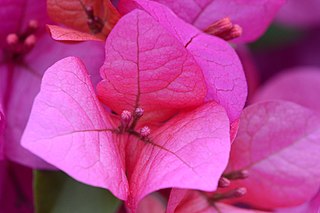
Bougainvillea is a genus of thorny ornamental vines, bushes, and trees belonging to the four o' clock family, Nyctaginaceae. It is native to eastern South America, found from Brazil, west to Peru, and south to southern Argentina. Different authors accept from 4 to 22 species in the genus. The inflorescence consists of large colourful sepal-like bracts which surround three simple waxy flowers, gaining popularity for the plant as an ornamental.
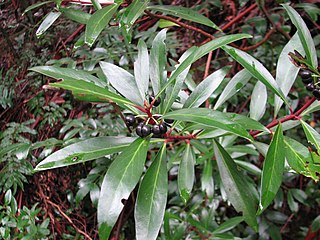
Tasmannia is a genus of woody, evergreen flowering plants of the family Winteraceae. The 40 species of Tasmannia are native to Australia, New Guinea, Sulawesi, Borneo, and the Philippines. The Winteraceae are magnoliids, and are associated with the humid Antarctic flora of the Southern Hemisphere. The members of the family generally have aromatic bark and leaves, and some are used to extract essential oils. The peppery-flavored fruits and leaves of this genus are increasingly used as a condiment in Australia. The peppery flavour can be attributed to polygodial.

Bridelia is a plant genus of the family Phyllanthaceae first described as a genus in 1806. It is widespread across Africa, Australia, southern Asia, and various islands of the Indian and Pacific Oceans.
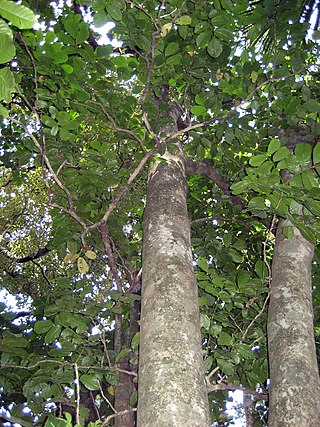
Dysoxylum is a flowering plant genus of trees and shrubs from the mahogany family, Meliaceae.
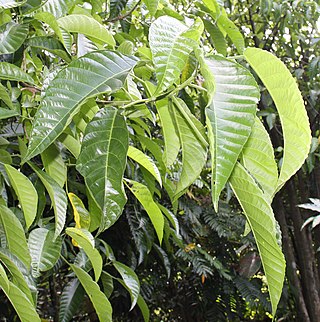
Dendrocnide is a genus of approximately 40 species of plants in the nettle family Urticaceae. They have a wide distribution across North East India, Southeast Asia, Australia and the Pacific Islands. In Australia they are commonly known as stinging trees.

Daphniphyllum is the sole genus in the flowering plant family Daphniphyllaceae and was described as a genus in 1826. The genus includes evergreen shrubs and trees mainly native to east and southeast Asia, but also found in the Indian Subcontinent and New Guinea.

Tasmannia stipitata, commonly known as the Dorrigo pepper or northern pepperbush is a rainforest shrub of temperate forests of the Northern Tablelands of New South Wales, Australia. Leaves are fragrant, narrow-lanceolate to narrow-elliptic, 8–13 cm long. Dark bluish to mauve berries follow the flowers on female shrubs. The species is dioecious, with male and female flowers on separate plants.

Astereae is a tribe of plants in the family Asteraceae that includes annuals, biennials, perennials, subshrubs, shrubs, and trees. They are found primarily in temperate regions of the world. Plants within the tribe are present nearly worldwide divided into over 250 genera and more than 3,100 species, making it the second-largest tribe in the family behind Senecioneae.
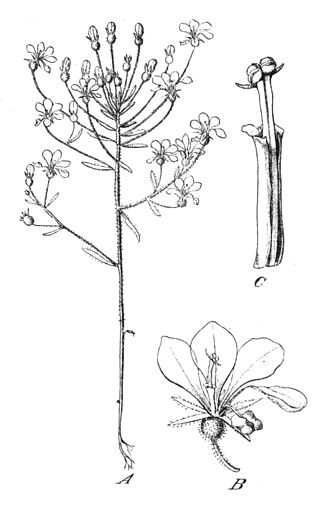
Levenhookia stipitata, the common stylewort, is a dicotyledonous plant that belongs to the genus Levenhookia. It is an ephemeral annual that grows about 7–10 centimetres (2.8–3.9 in) tall with oblanceolate to linear leaves. Flowers are pink and bloom from August to January in its native range. L. stipitata is endemic to southwestern Western Australia where it grows in granitic or lateritic soils. This species was first described by George Bentham in 1837 as Stylidium stipitatum and was later reclassified into the genus Coleostylis, which was placed into synonymy with the genus Levenhookia.

Leersia is a genus of plants in the grass family which includes species known generally as cutgrasses.
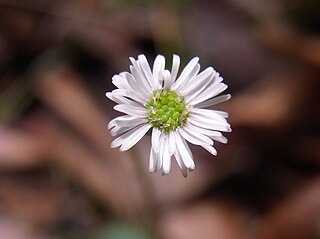
Lagenophora is a genus of flowering plants in the family Asteraceae. Species occur in South-east Asia, Australia, New Zealand, as well as Central and South America.
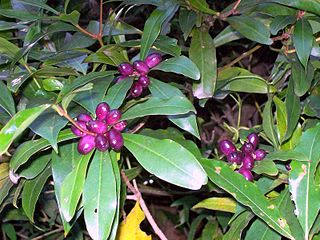
Tasmannia insipida, the brush pepperbush, is a shrub native to Australia that can grow 1 to 3 metres high with reddish stems.
Flora of China is a scientific publication aimed at describing the plants native to China.

Lagenophora gracilis is a small plant in the family Asteraceae, found in eastern Australia, and in tropical Asia. Common names include slender bottle-daisy and slender lagenophora. The habitat is the floor of Eucalyptus forests, often in moist situations.
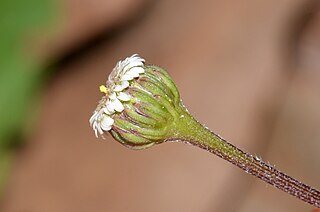
Lagenophora huegelii is a species of flowering plant in the family Asteraceae which is endemic to Western Australia. It was formerly considered to also grow in eastern Australia and Tasmania, though these populations are considered a separate species: Lagenophora gunniana.

Atriplex stipitata, commonly known as mallee saltbush, bitter saltbush and kidney saltbush, is a species of shrub in the family Amaranthaceae, found in all mainland states of Australia.



















